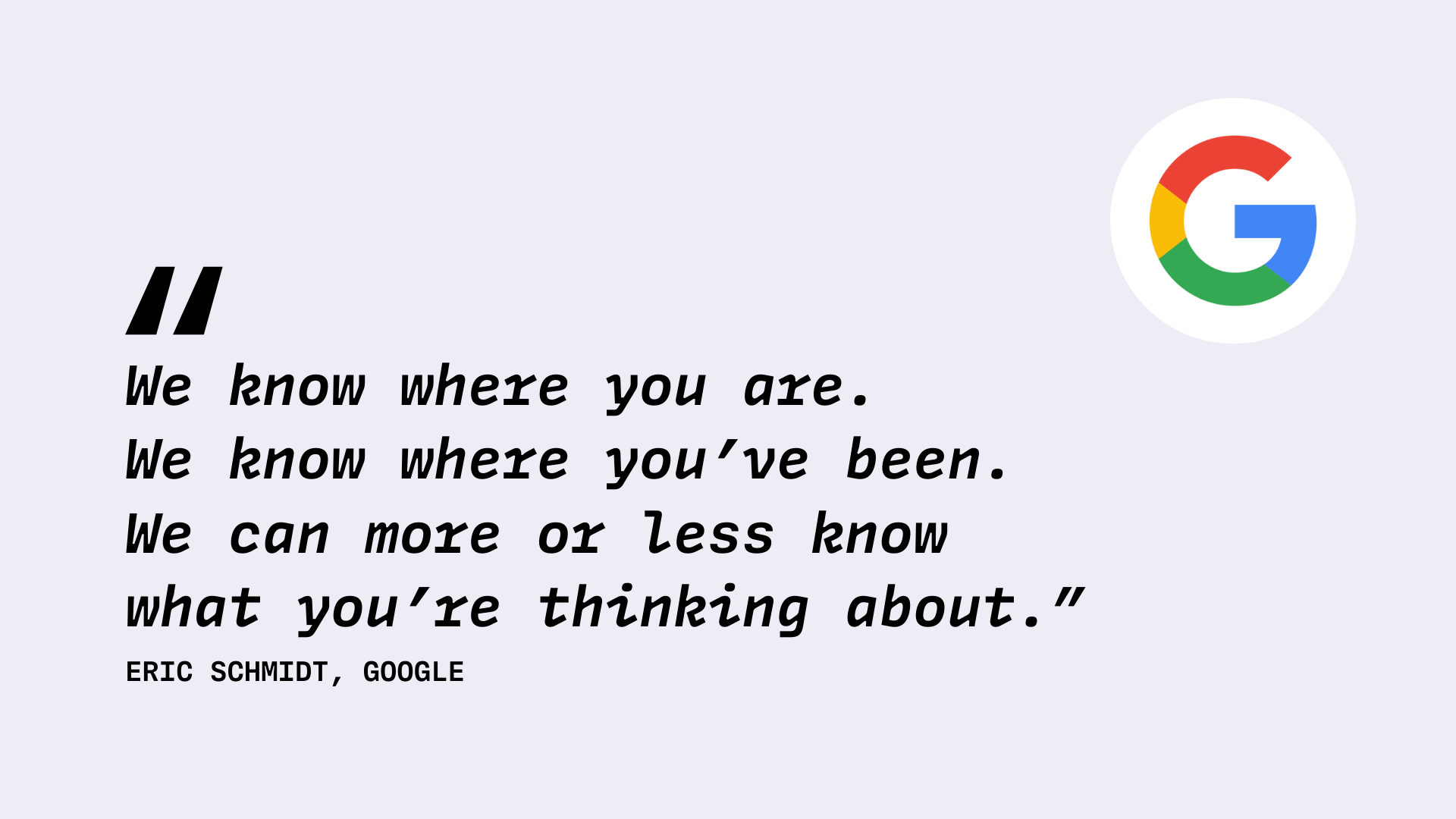Everything Google knows about you and how to stop it!
Ever thought ‘What does Google know about me?' the short answer – A LOT. But you can stop them from collecting more, here's how!
Quick Summary: The types of data Google collects
If you’re the average internet user and haven’t changed your default Google settings, every time you use Google it’s currently able to collect the following data:
- Your personal information: your name, gender, date of birth
- Your email addresses and phone number
- Where you live
- Your current location
- Your interests
- Where you work
- What you search for
- Every website you visit
- Ads you click on
- The videos you watch
- Places you’ve visited around the world
- Your device’s information
- IP address and cookie data
- YouTube search history and your recently watched videos
- Anything you’ve said to the Google Assistant (even through smart speakers)
Google knows way more about you than you think it does, and if you use its services then you can assume it knows everything. Do you remember Eric Schmidt’s (former Google CEO) famous quote from 2010?
”We Know Where You Are. We Know Where You’ve Been. We Can More Or Less Know What You’re Thinking About.”
And with the rise of AI, this quote is probably more true than ever before!
32 years after the launch of Google Search and 20 years after the launch of Gmail, we’ve put together a collection of all the things Google knows about you, including what personal data Google collects, how to reduce Google’s tracking, and how to delete your data from their data-hungry servers.
On every smart device you own, it’s highly likely there’s one, if not more Google-owned apps or services. Think about it – Google Search, Chrome, YouTube, Google Play apps, Google Maps, your TV Chrome cast, these are just a few Google products we use daily, have readily available, and often open on our devices. Google has said publicly that it collects personal information and tracks users through its apps, so this is no secret at all. But what a lot of people fail to realize is the extent of this tracking, data collection, and scope the tech giant has into your life.
Every time you search something on Google, Google in return learns something about you based on your search. And every time you use a Google-owned site like Google Maps or YouTube, the tech giant builds user profiles based on your search and browsing history. - But you can use alternatives, for instance instead of Google Maps. - Through this mass data collection it can build advertising profiles, and spam you with ads it thinks match your demographic. By tracking your online activity through invasive measures like fingerprinting, Google is able to make extremely accurate predictions on your gender, age, marital status, personal interests, and even income!
Today Google knows and collects so much about its users, that people around the world are actively choosing to Degoogle, which means stopping using all Google services and opting for privacy-focused alternatives that better respect user privacy.
Continue reading to find out what types of information Google knows about you, what data Google collects from you, how to improve your Google privacy settings, and how you can delete Google’s stored data.
Why does Google collect my data?
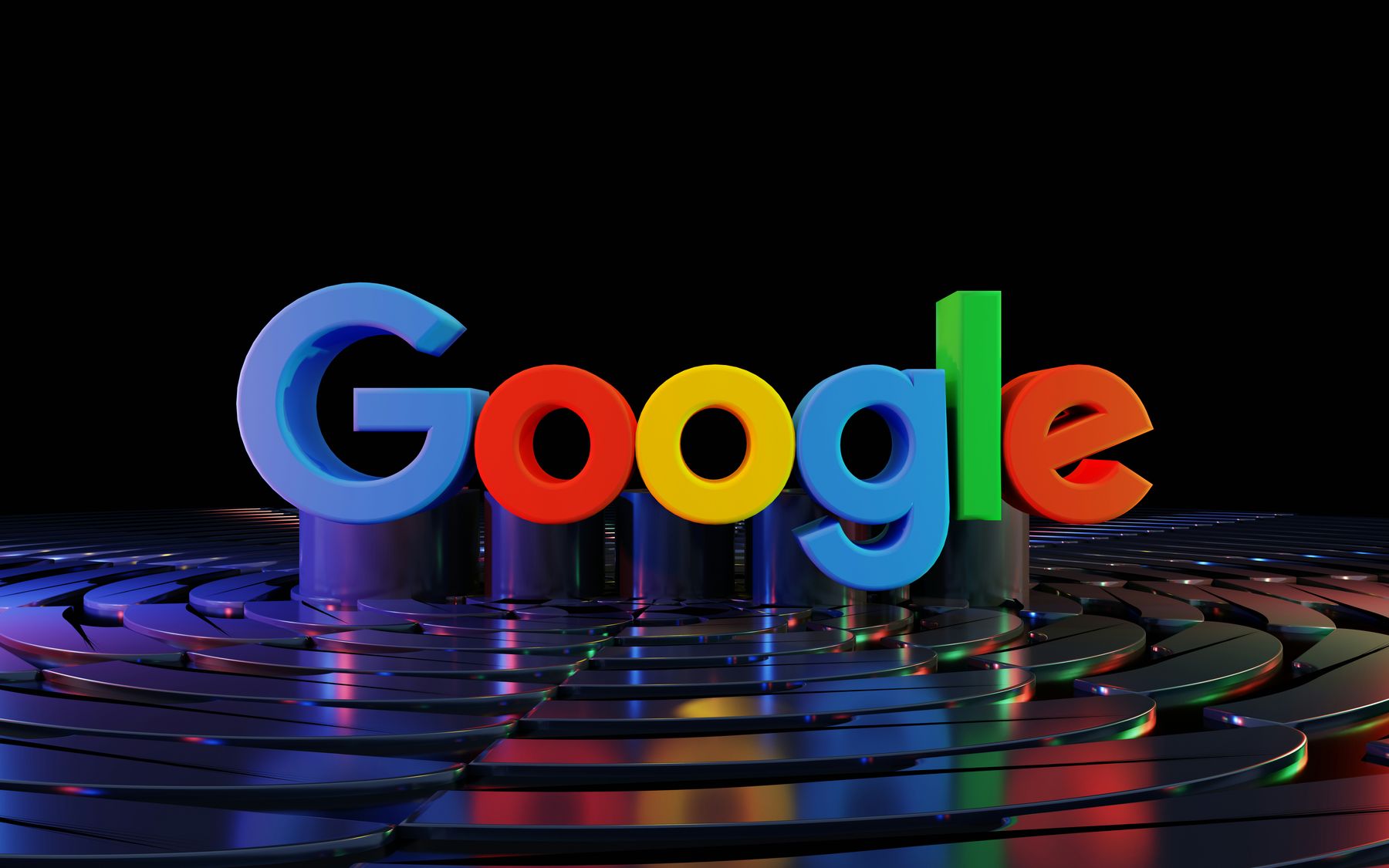

Google collects your data for a number of reasons, but most importantly to make profits off selling your data to advertisers.
If you’re wondering why Google collects so much of your data – the short answer is to make unimaginable amounts of revenue by selling your private information to advertisers. Remember, Google makes most of its revenue through advertising.
Google collects personal data so that it can target ads and apparently ‘personalize’ your experience. Because Google collects your data, and creates accurate profiles based on this, this information is sold to advertisers to improve ad targeting and increase its sales. When it comes to collecting and using user data, the Tech Giant is limitless with how far it will go. For example, it’s using your data to train its AI models, and it’s introducing Gemini AI into more of its products, like Gmail. Google is even quietly rolling out sneaky updates on Android so that Gemini AI has access to more apps.
So, if you’ve been wondering, what does Google do with my personal information? To summarize, Google collects your information (in extremely invasive ways), sells it to advertisers, who then spam you with targeted ads online. By using Google’s free services, you in turn pay with your privacy and data – and ultimately become the product.
One immediate step to protect your data from Google is to choose a private browser instead of Chrome.
How to see what Google knows about you
Due to legal reasons, you’re allowed to access all the information and personal data Google has collected from your online activity over the years. Follow the steps below to see what data it collects and all the personal data it has stored about you.
- Open your Google account
- Go to the navigational panel and click Data & Privacy
On this page, you will be able to see a full summary of all the data Google has collected from its apps and services that you use. This includes history settings, ad settings, and others we will go more into detail about later.
Explore Google history settings: Things you’ve done and places you’ve been
Under Things you’ve done and places you’ve been you can see every Google primary service you use, and the data collected for each service. It’s no secret that Google app tracks and monitors our every move, but once you’ve reviewed all the data collected about you, you’ll realize just how deep Google’s reach into your private and personal life is.
Google tries to justify this tracking and storing of your every move by saying, “Rediscover the things that you’ve searched for, read and watched, and see the places where you’ve visited.” - A bit creepy, right?
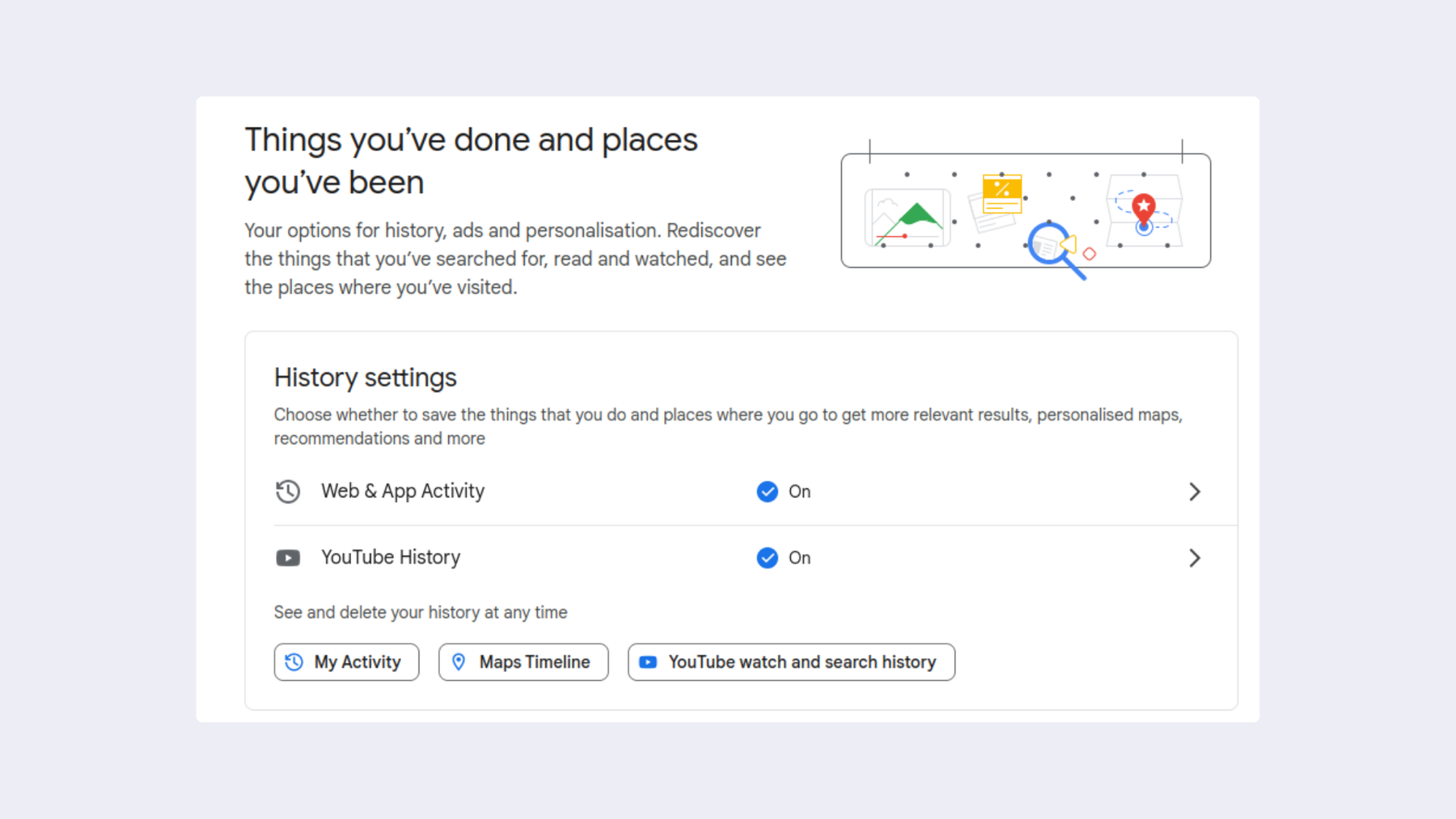

Under ‘Things you’ve done and places you’ve been’ you will find everything you’ve searched for, read, watched, and visited.
Web & App Activity
If you go to My Activity found under History Settings you will find a list of every single website you’ve ever visited. The data from any Google apps you use will also appear here. And if you use Google Workspace and had already turned off activity tracking, you will need to check these settings again – yes, Google might have turned on activity tracking even if you had turned it off in the past! On Android, you also need to disable Gemini AI tracking as it is now built-in by default.
Under My Activity all your Google activity will be listed along with:
- The date you used it
- The hour
- The app used
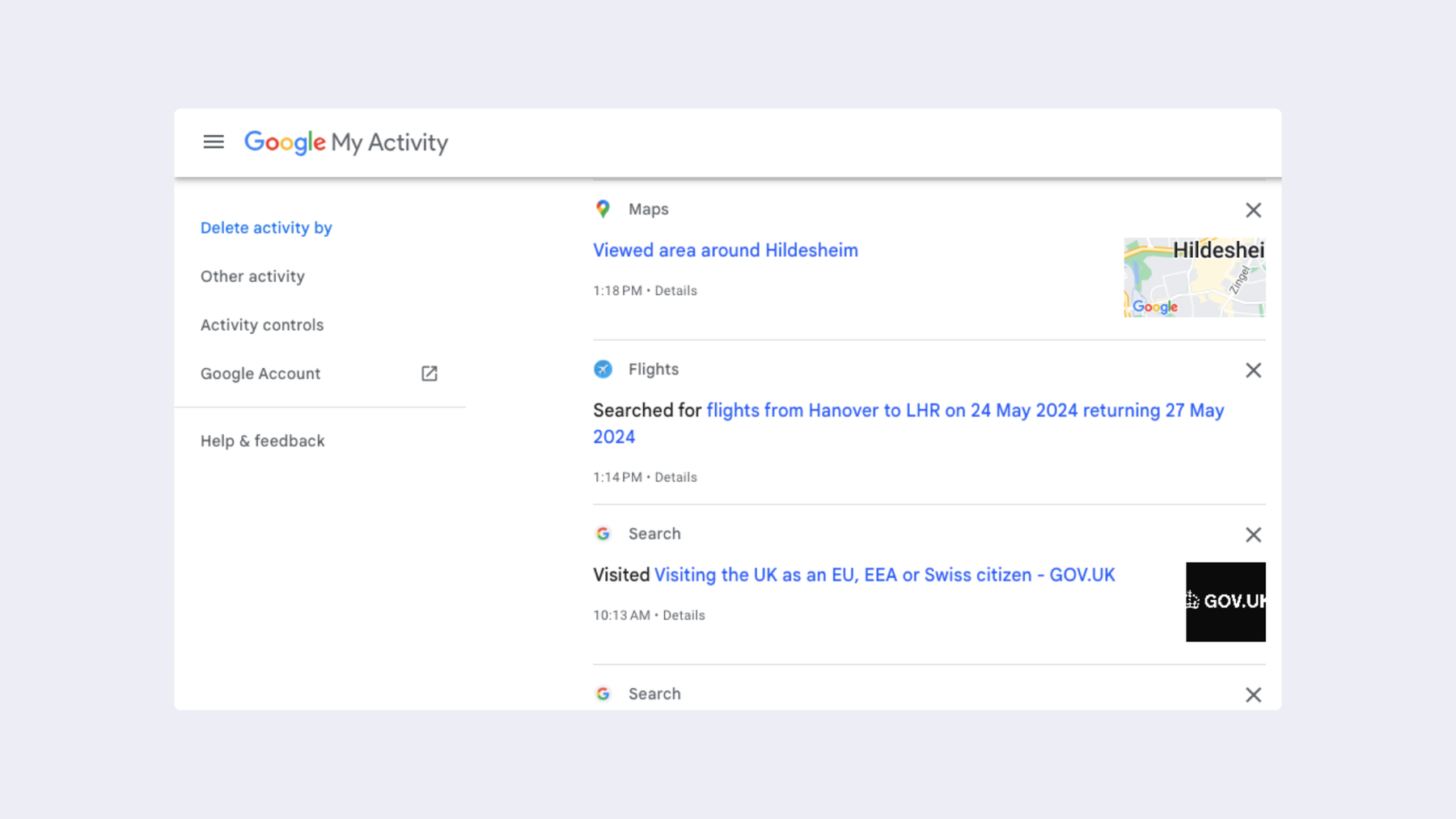

Google keeps a list of all your Google activities. Above you can see Google Flights, Google Search, and Google Maps were used. Each time you use a Google app, it keeps a log of every click, scroll, or step you make.
Location History
Google’s location history gives you a full list of the places you’ve been and even a Google Maps Timeline including the routes you’ve traveled. If you are like billions of others around the world and use Google Maps on your smartphone, then every step you take is tracked and put into what Google calls your ‘Timeline’. Every time you leave a Google review or use a location service this data is also logged and stored. If you ever forget what you did on a day, specific time, or where you were – Google has been tracking you, and can give you the exact answer! While there are location settings you can change to reduce the tracking, if you really want your whereabouts to remain unknown, you should completely stop using Google.
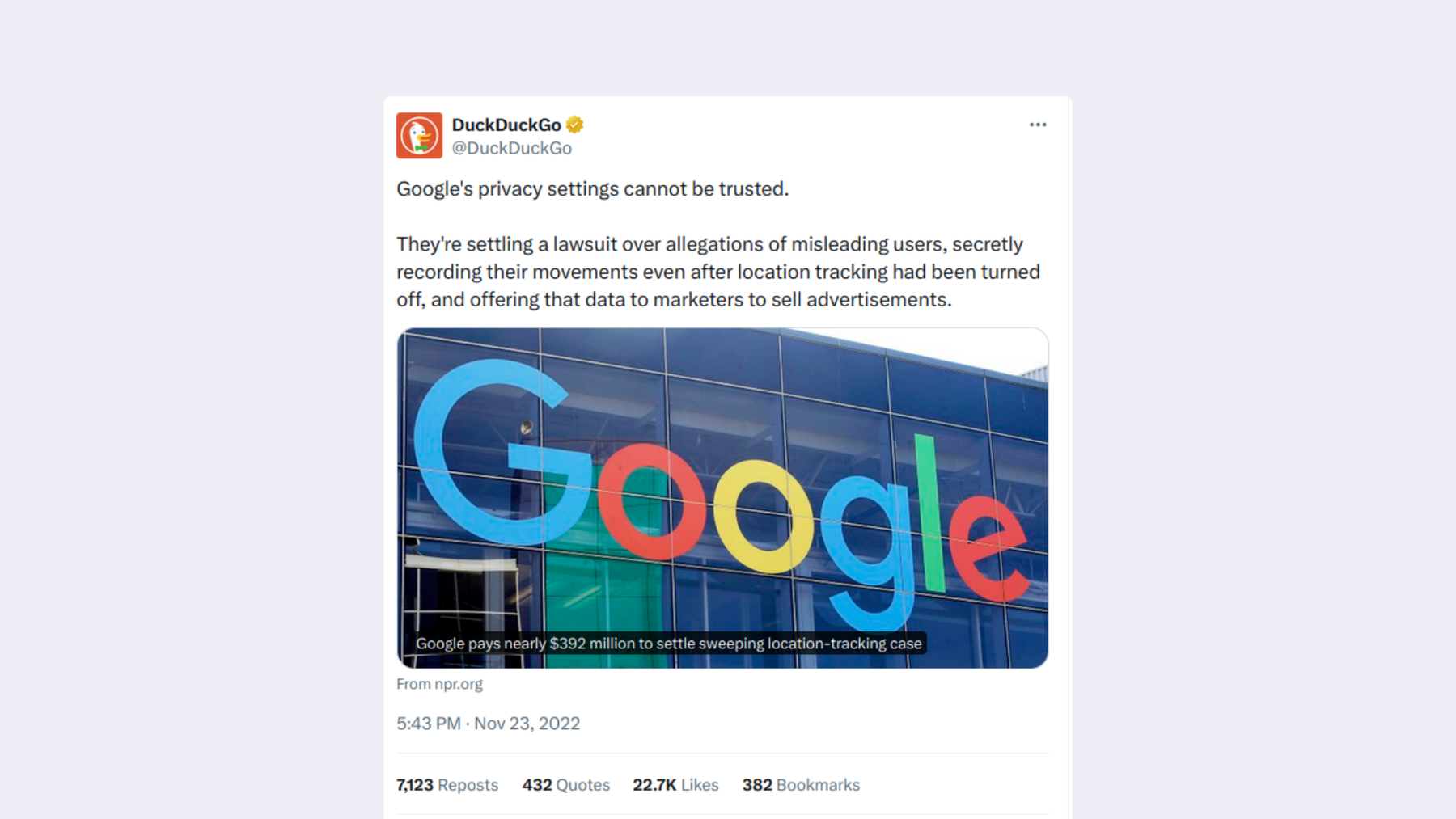

Google is settling a lawsuit against them for recording its user’s movements even when they had turned off location tracking. Image source: DuckDuckGo on X.
YouTube History
Every time you use YouTube to watch your favorite YouTuber or Music video, this information is also stored and kept by Google. Under YouTube History you will find what you searched, the date you watched the video and even the device you watched it from.
There are sites like Invidious which allow you to watch YouTube without being tracked and with zero ads. But of course, Google has tried to get this privacy alternative, Invidious shut down as it threatens its business model and would ultimately kill a large percentage of revenue if it became popular enough. Unfortunately for you, if you’d like to watch YouTube with no adverts you’ll need to get that wallet out and pay for a Premium account. It’s worth noting that paying for a premium account doesn’t stop the tracking, just the ads.
Personalized ads
- Under Data and Privacy scroll to Personalized ads
- Click the arrow to the left of My Ad Centre
- Click Manage Privacy
Under Manage Privacy in My Ad Centre you’ll be able to see how your ads are personalized, as well as what details Google uses to personalize ads based on what it thinks you might be interested in.
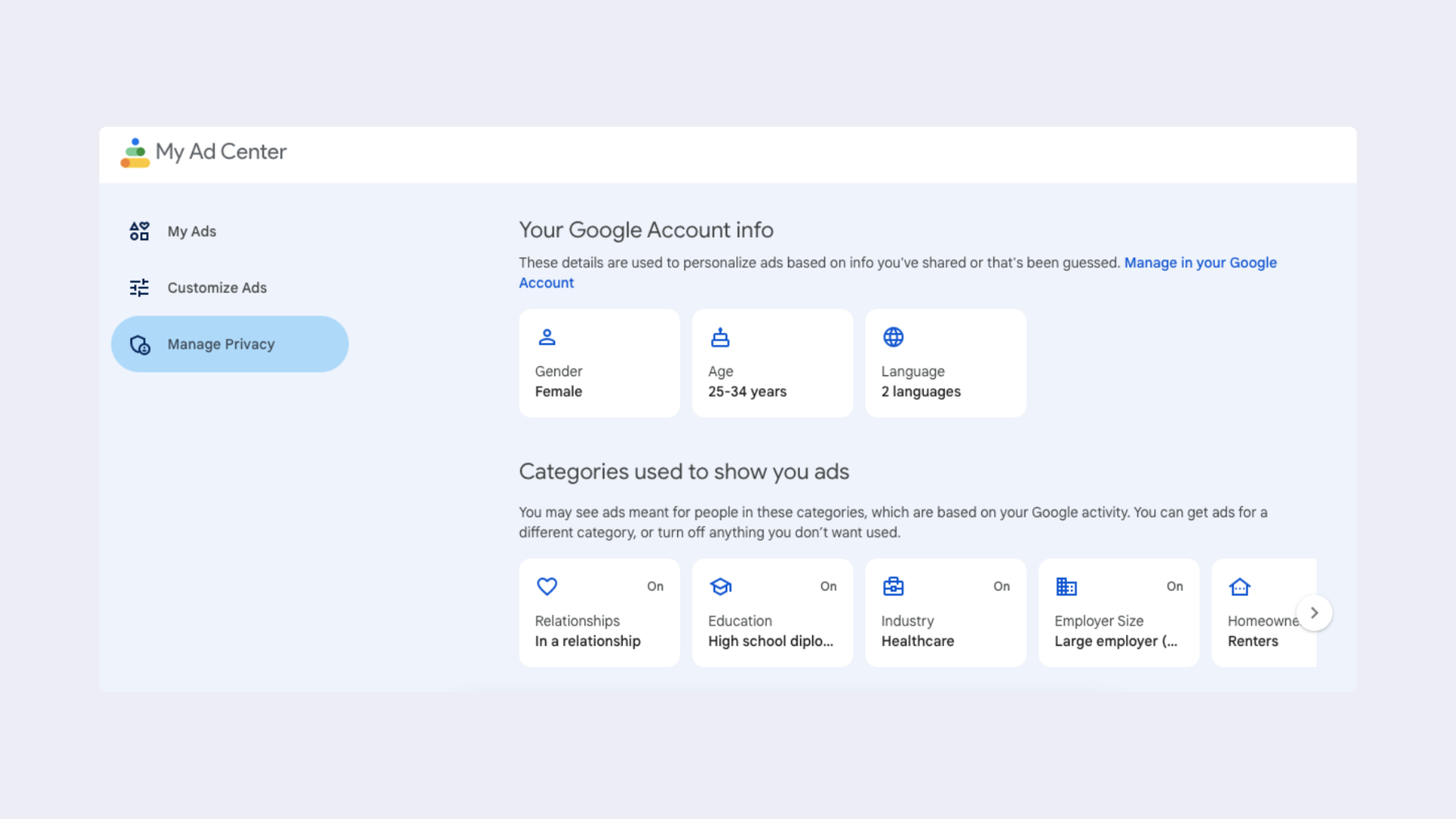

Every time you use a Google service, Google tracks your activity and uses your activity to personalize your ads – the amount of information Google knows and has guessed correctly is creepy!
The information google uses for ad targeting and personalization is information you have willingly shared with Google like your gender and age.The other information Google has guessed about you is based on your Google activity.Every time you use a google app or service it tracks you, analyzes what you do and uses this activity to personalize the ads you see. In my case, the information Google guessed about me based on my activity and searches were in fact very accurate!
Explore what information you share with others
On the Data & Privacy page, scroll down to Info you can share with others here you’ll see the personal information that’s saved to your Google account, like your name, date of birth, contact information and gender.
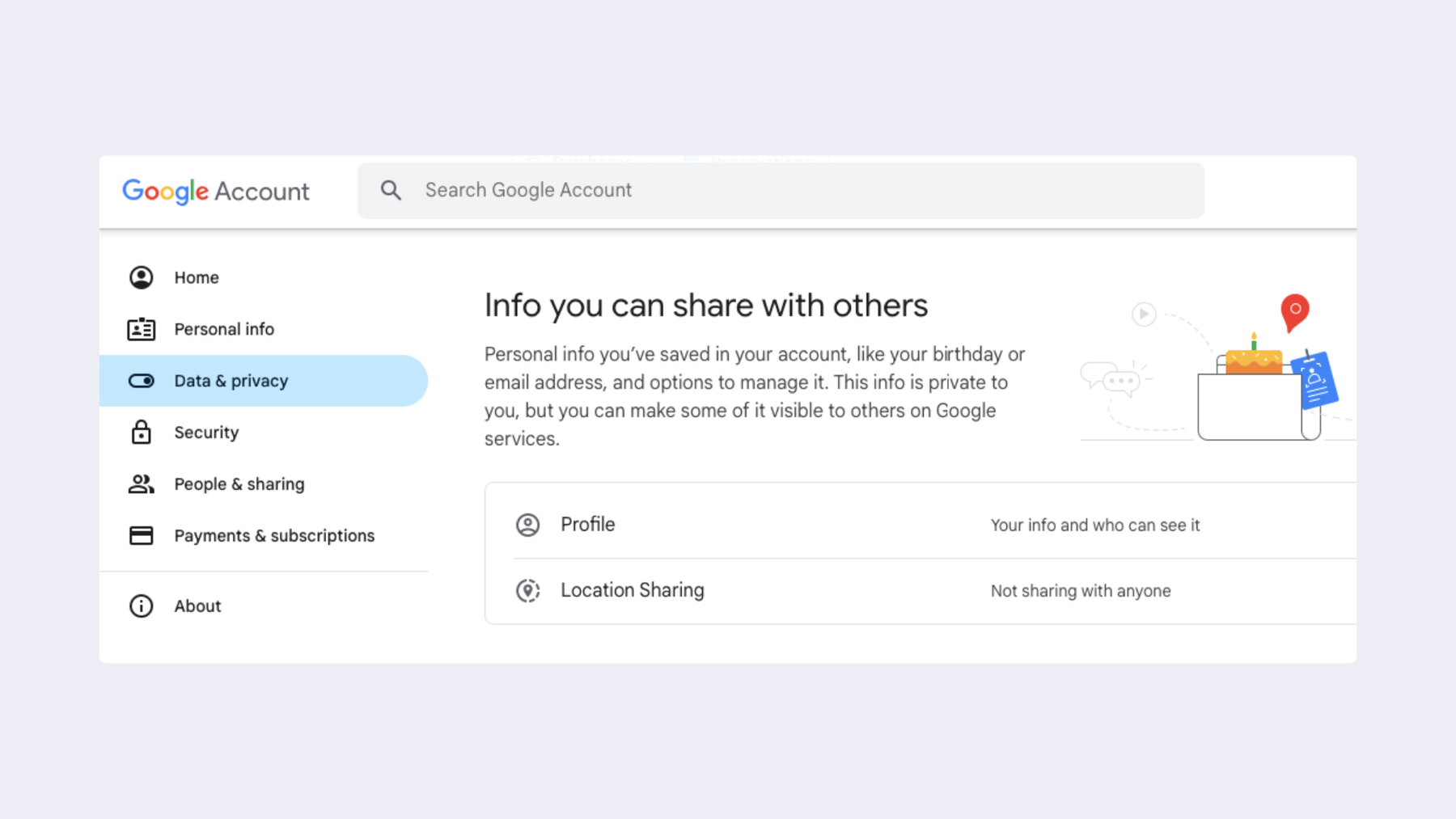

Under ‘Info you can share with others’ you can see a list of personal information Google already has stored about you and change the settings to make it private or accessible to specific contacts.
Data from apps and services you use
Under Data from apps and services you use you will see Content saved from Google services if you click the arrow on the left you can see every Google service you use as well as the data that’s collected from them. It also gives you the option to download your data from these Google services, or the option to delete a Google service you use, like Gmail, YouTube, or Google Drive.
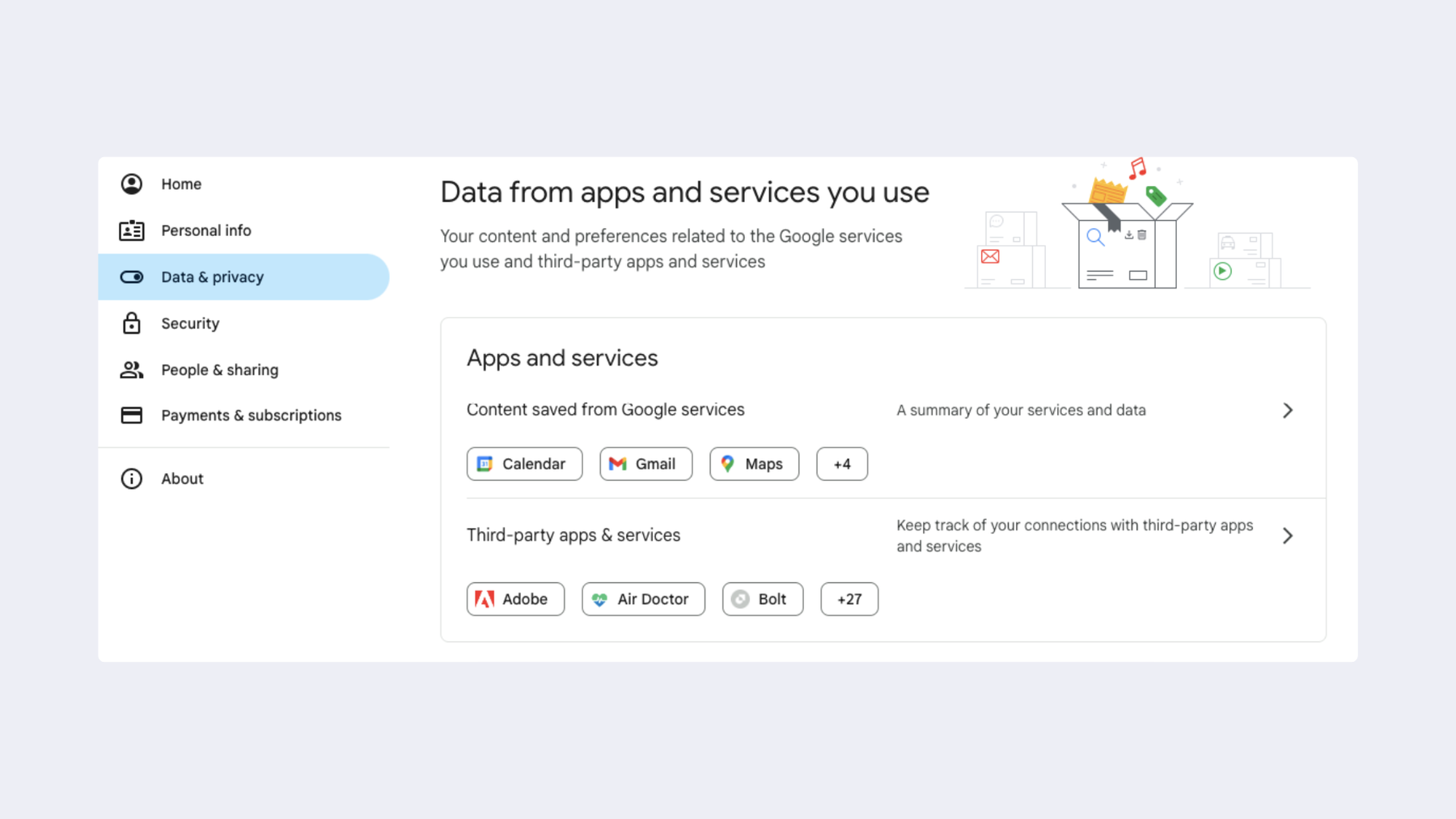

Google has collected all your data from the apps and services you use.
Every time you install a third-party app and extensions (not Google apps) they give you the option to sign up and log in with your Google account. So instead of creating a new username and password for the app or service you need, you can use your Google credentials. This makes creating an account super easy and quick, but it comes with the cost of allowing other apps and extensions access to your Google data and Google to access data from those apps. Under Data from apps and services you use go to Third-party apps & services to see a list of every third-party app and service that’s linked to your Google account. From here you can click the arrow to the left of each app to review the app or service linked to your Google account. You should have the option to Stop using Sign in with Google or to Delete all connections you have to the specific third-party app.
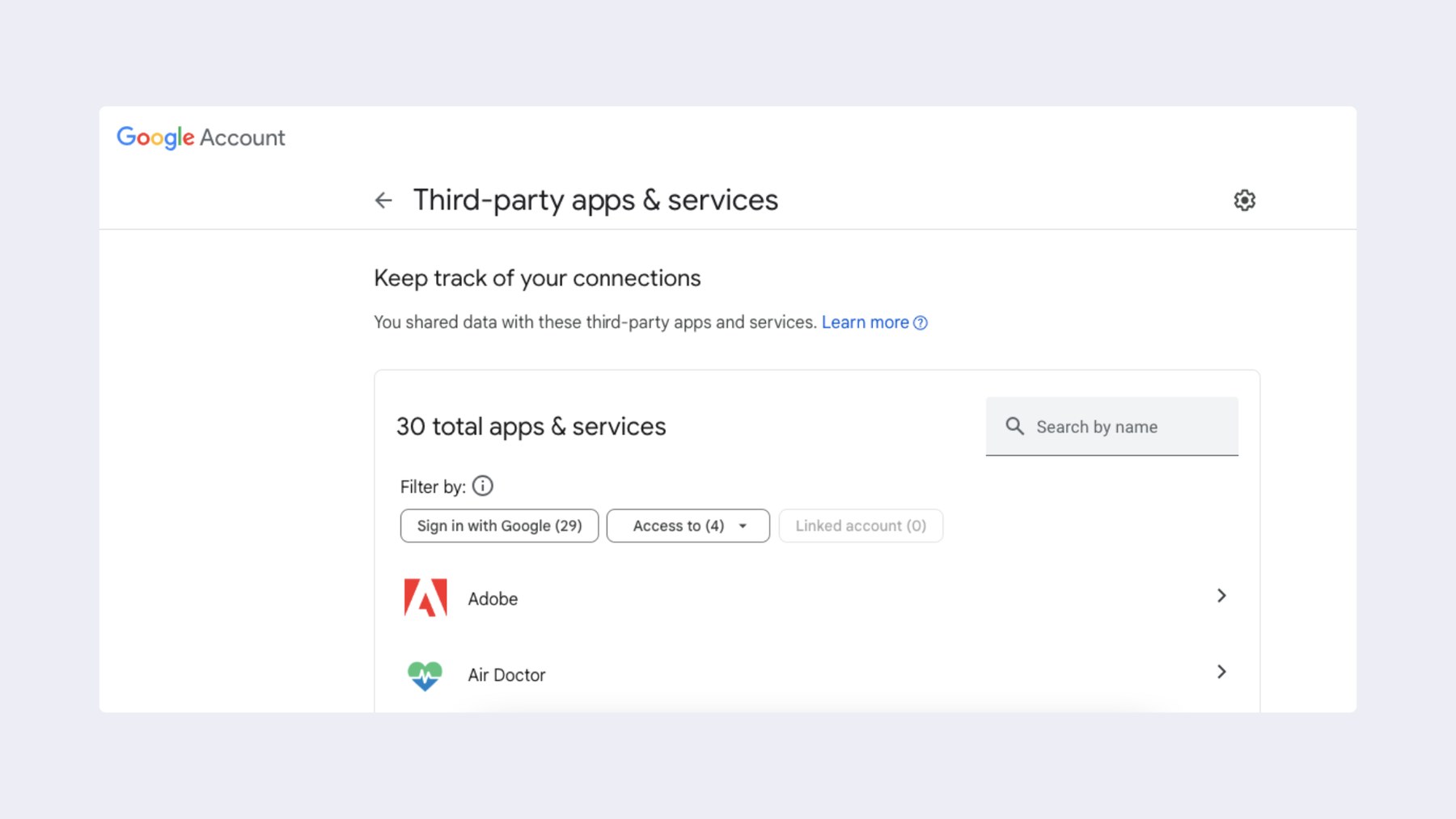

Each time you create an account for a new app or service like Adobe, Bolt, Canva, or Grammarly and use your Google log in to create the account you are giving third-party apps and services access to your account data.
Google Analytics
Google Analytics is a free Google service that’s used by tons of websites and apps globally. In fact, Google Analytics is the biggest cross-site tracker to date. It currently lurks in about 72.6% of the top 75k websites. While Google Analytics allows apps and websites to gain insights into who’s using their apps or visiting their website, this tool also lets Google add the analytics to its mass database of profiles about people.
What data does Google Analytics collect? Google Analytics tracks a sites page views, and different types of visit data like, the users operating system, device type, and browser type. It also tracks your demographics like age, gender, location, and interest. These are just a few sets of data it tracks and collects. Google Analytics tracks so much that it can lead to GDPR infringements if used by European companies.
What’s scary is that with this data Google is able to track is used by many industries in different ways. An example of this is airlines use this data to charge internet users different prices depending on their personal information. Google even states that “Prices may vary” when you search for hotels or accommodation based on the factors, Google account sign-in status, the device you use and “whether you’re part of an audience list” so Google has even gone as far to create personalized pricing based on your digital profile! Additionally, Google’s Gmail tracks everything you buy too. So even your Gmail mailbox which is supposed to be private is collecting your purchasing data, storing it, and has records on every purchase you’ve made.
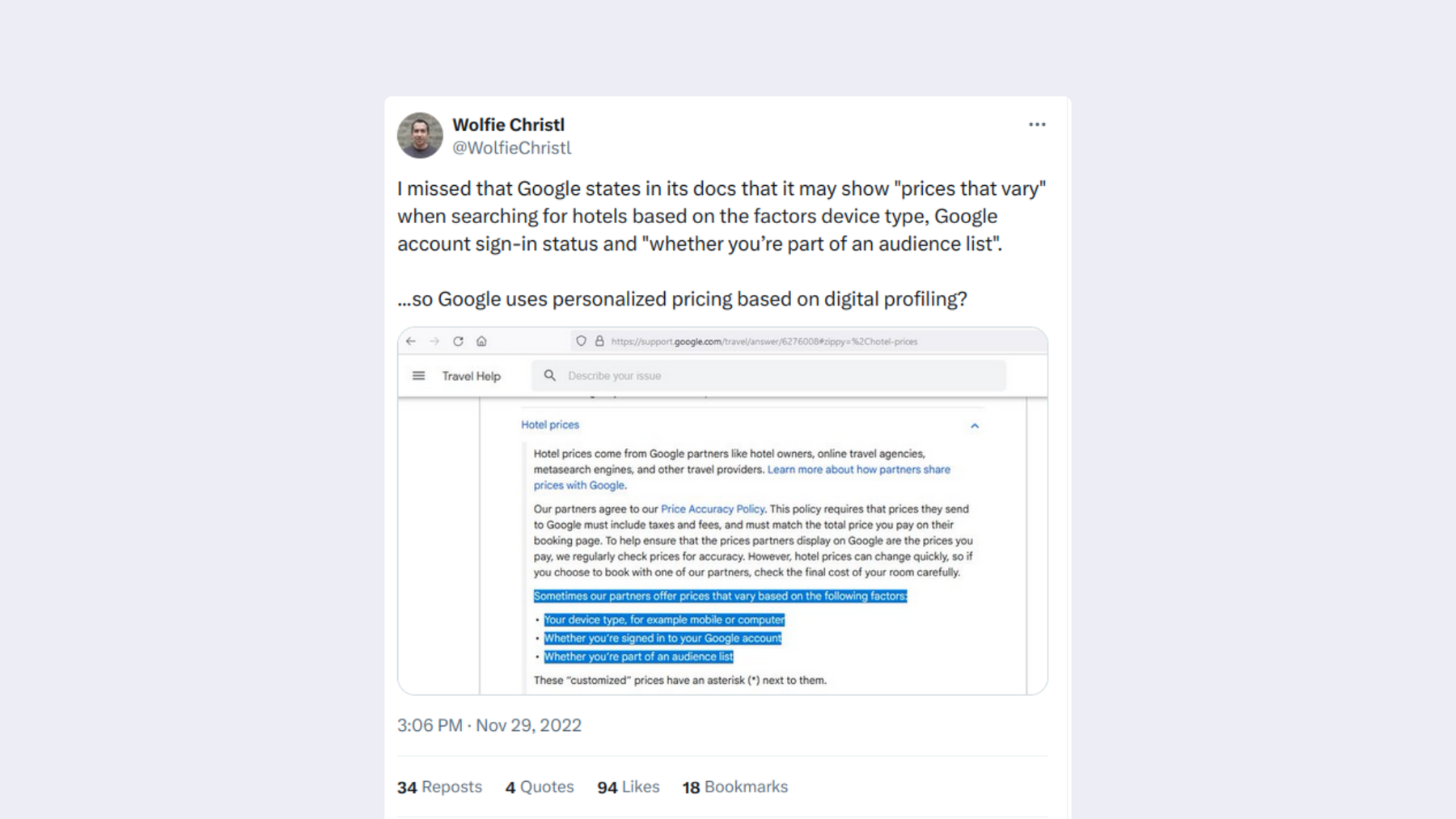

Google uses a range of factors like your device type to change the prices for certain products online. Want to book a hotel? Well, it looks like Google will decide the price for you!
How is it fair that this disgustingly large corporation gets to decide who pays what based on their online profile and goes as far as to keep records of your purchases?
How to export all your data from Google
Before we get into the details of how to increase your privacy and reduce Google tracking, you might want to export all the data saved to your Google account.
Follow these easy steps to download your Google data:
- Under Data and Privacy scroll down to Download or delete your data
- Click the arrow to the left of Download your data
- Select which data you want to download from each Google service.
- Click Next step
- Select the destination you’d like to send the exported data to.
- Select the frequency of export, you can choose either export once or export every 2 months for one year.
- Select the file type and size.
- Click Create export
Steps to increase your Google privacy and stop the tracking
So now that you’ve been filled in on all the invasive ways Google tracks you, stores your online history, collects your data, and sells it for profit, it’s time to take back your privacy and stop it from collecting your data.
In this next section, we’ll show you what privacy settings to change, how to stop data collection, and limit the information Google stores about you. What’s important to remember is that while there are settings you can change, it doesn’t mean you are completely private – Google will always track and have some kind of insight into your actions and life as long as you use their services.
How to turn off Google ads personalization
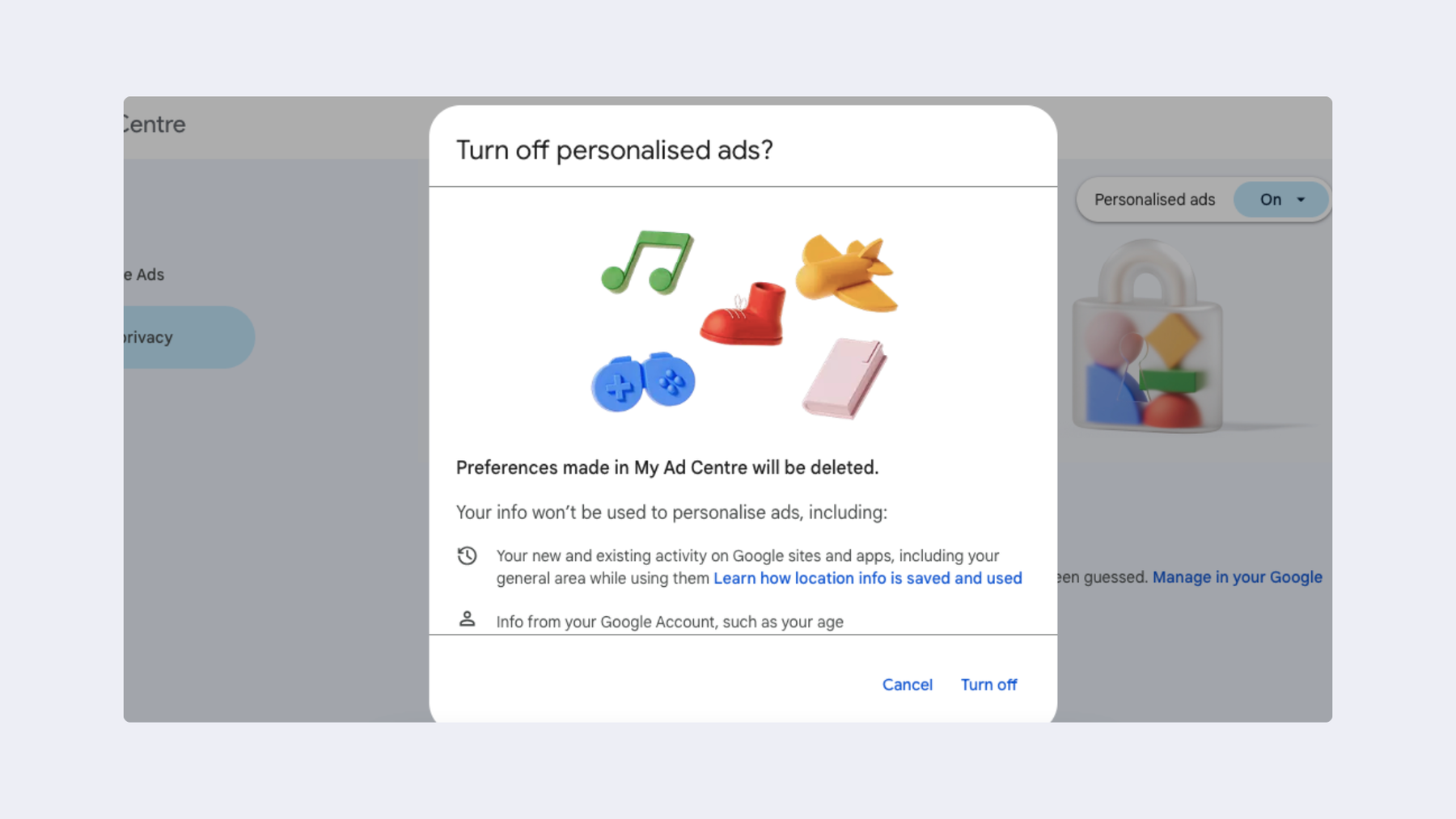

By turning off Google Ads personalization you will reduce Google’s tracking and stop the ad targeting.
The first thing you should do to stop Google’s tracking is turn off ad personalization. There are many other settings to disable, but this is the most important. Be warned – Google will try to get you to keep ad personalization on by convincing you that turning it off will negatively affect your internet experience but this is rubbish! What it means is that it will no longer be allowed to ad target you.
Follow these steps to turn off ad personalization:
- Open your Google account
- Go to Data and privacy
- Under Ad settings click Ad personalization
- Click the toggle next to Ad personalization is ON
- A pop-up will appear click Turn off
Once you’ve turned off ad personalization you will see ads based on some factors it can still get from tracking your activity but they will be more general – please don’t make the mistake of thinking this stops them from tracking you entirely. That doesn’t exist.
Removing third-party access to your Google data
Ever wanted to create an account with a new service or app and been given the option to sign in with your Google account? It’s quick, easy, and convenient. But linking your Google account to third-party accounts allows these third-party accounts access to your Google information. It’s highly recommended that you review which third-parties have access to your information.
To do this follow these steps:
- Open your Google account
- Go to Data and privacy
- Scroll down to Data from apps and services you use
- Click on the arrow to the right of Third-party apps & services
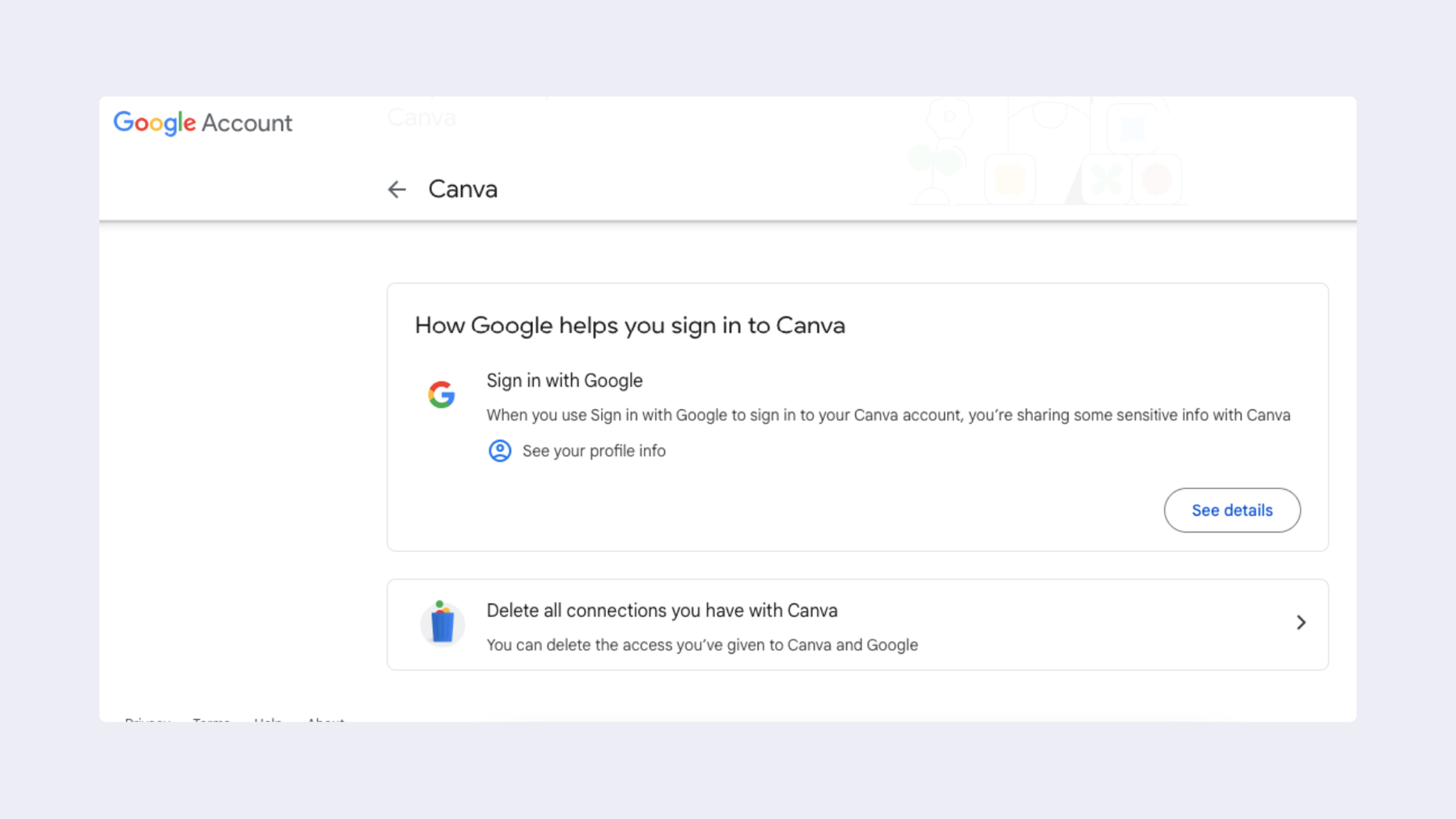

By removing third-party access to your Google account, these third-party services will no longer have access to your private information stored in Google. You will see a list of third-party services that have access to your account. From here you can edit the permissions and disable access for each service.
How to delete Google Data
How to turn off and delete Google web and app activity
The amount of information Google collects and keeps from your activity on their platforms is concerning!
Here’s how you can turn off this automatic collecting and delete this activity:
- Open your Google account
- Go to Data and privacy
- Scroll down to History settings
- Click on the arrow to the right of Web & App Activity
- Click Turn off
- Click Turn off and delete activity
- A pop-up will appear, click Next
- Select the activity you want to delete – we recommend selecting all.
- Click Next
- Lastly, click Delete
Delete and disable Google location history
It’s scary to think that Google even tracks and knows your location. And even scarier to know that it has been collecting your location history.
To disable and delete location tracking follow these steps:
- Go to Location History
- Click Turn off
- Select Turn off and delete activity
- A pop-up will appear, click Next
- Click Delete
- Click Ok
To delete your location history follow these steps
- Go to Google Maps Timeline
- A pop-up will appear, click Skip
- Click on the gear icon at the bottom of the map.
- A menu will open, click Delete all Location History
- Click the box to confirm you understand and want to delete all location history
- Click Delete Location History
- Click Ok
Delete and disable YouTube History
To enable auto-delete of your YouTube history follow these easy steps:
- Open your Google account
- Go to Data and privacy
- Under History Settings go to YouTube History
- Under Auto-Delete (on) click the arrow
- Make sure Auto-delete activity older than is selected
- Choose after how many months you’d like the activity to be deleted - we recommend 3 months.
- Click Next
- Click Confirm
- Click Ok
To disable your YouTube history do this:
- Open your Google account
- Go to Data and privacy
- Under History Settings go to YouTube History
- Click on the arrow to the right.
- Under YouTube History click Turn off
- A pop-up will appear, click Pause
- Click Ok
For many of us it’s easy to spend time going down a rabbit hole, watching different content on YouTube. While you might think you’re watching this alone, from the comfort of your home in private - this is far from true! Google is watching and storing every video watched, every like or comment, and every second of watching time. Make sure you disable your YouTube history as well as enable auto-delete.
The best solution? Delete your Google account.
If you’re now asking yourself, “Should I worry that Google knows so much about me?” the answer is yes! While we have given our tips for the settings you should change to increase your online privacy, the truth is that as long as you use a Google service you are giving away your data, being monitored and even paying different prices based on your online profile! Maybe just not as much – but it’s still happening. At the end of the day the best thing you could do to protect your privacy is to delete Google entirely.
Note: Before permanently deleting your account, be sure to remove any third-party apps linked to your Google account to avoid not having access to them, as well as exporting all of your Google data.
To delete your Google account follow these easy steps:
- Open your Google account
- Go to Data and privacy
- Scroll down to More options
- Click the arrow to the right of Delete your Google Account
- Enter your account password and click Next
- Select the two boxes at the bottom of the page
- Click Delete account
Better alternatives
It’s no surprise if you want to delete your Google account and every service linked to it, but at the same time, you might be worried about your Gmail account. Luckily there are many better Gmail alternatives like Tuta Mail. If you want to delete a Gmail account and take back your privacy we’ve put together a full step by step guide to safely deleting your Gmail account .
Your quest for privacy doesn’t stop here. Next steps could include seeking to have your data removed from other sites and by switching to private alternative platforms.
While deleting your Google account might feel scary and impossible, there are many better privacy-focused apps and services available these days which means you can still do everything you could do with Google but with alternative services that are ethical in how they operate and respect your privacy. Leaving Google behind doesn’t need to be difficult, we’ve put together a quick guide to take back your privacy online!.
Looking for a mailbox with zero tracking and zero ads?
Ditch your spam-filled mailbox and delete Gmail now! We have a better alternative - Tuta Mail.
Tuta is a privacy-focused email and calendar service that offers a fully end-to-end encrypted mailbox and calendar for free! Gone are the days of email scanning, targeted ads, and massive tracking. With Tuta Mail you can have peace of mind knowing that none of your payments, receipts, or messages are being scanned and recorded - Tuta is so private and secure that not even the employees at Tuta can access your messages, additionally the whole mailbox is end-to-end encrypted. This includes the subject line, your contact list, and even your Tuta Calendar and Contacts!
Sign up for Tuta anonymously to enjoy free end-to-encrypted email with generous storage space, zero tracking, and no ads!

